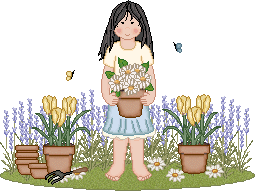Lady's Heart of the Home |
 Spinning Wheels of Colorby Carrie P. WilliamsWith spring only a month away, many of us are beginning to pour over seed catalogs and plant magazines, wondering which mix of annuals and perennials will be the best combination for our gardens. However, with so many variations of color out there, it can be so hard to choose! The decisions get even harder when you are not sure which colors would look best with the reddish-pink brick of your house or the bright yellow foliage of your variegated euonymus hedge. The frustration can be enough to make you consider an all-white planting of petunias. Thankfully, there is an easy, methodical way of determining what color scheme will work the best for your property, and it all starts with a little tool called the color wheel. Color hues are arranged on this wheel in such a way so you can easily determine the different relationships between colors. There are different color relationships that you can go by, depending on what look you want in your landscape. By applying the colors of your existing landscape to the color relationship of your choice, you then come up with a good color scheme for your property. A color relationship that is used quite often with great effect in the landscape is the complimentary color relationship. Complimentary colors are two colors that reside completely opposite each other on the color wheel. Some well-known complimentary colors are yellow and purple, red and green, and blue and orange. Using these colors create contrast when used in bold sweeps, but they also create a more neutral tone when mixed together. A plant example of this is yellow coreopsis with violet verbena. Another fantastic color correlation for the landscape is the analogous color relationship. This combines colors that are adjacent to each other on the color wheel. Some examples of this are "green, blue-green, blue", and "yellow, chartreuse, light green". This color combination can be pleasing to the eye and create a sense of unity. An example of this combination in the landscape are bleeding heart, violets, and spring iris. The last color relationship that is often used in landscaping is the triad relationship. This consists of three colors that are equidistant from each other on the color wheel. A well-known example of this are the primary colors of blue, yellow, and red. You can also turn the triangle that connects the colors in the wheel to create a combination of blue-violet, red-orange, and chartreuse. An example of this in the flower realm is a combination of dark orange black-eyed susans and violet asters planted against a yellow-variegated shrub. There are some other color relationships to be made from the color wheel which you do not see as much in landscaping. However, if you are interested in differing from the norm, feel free to peruse the literature to see what you can come up with. After all, as long as you create a color combination that is pleasing to your eye, that is all that matters. So go on and delve into the world of color so you can pull out a fantastic color combination for your property. Once you've pick the perfect color combo, match up your favorite variety of plants to it so you can have a fabulous, eye-pleasing landscape of color for your own home. Carrie P. Williams is a professional landscape designer with Turf Tamer, Inc. She has written many informative landscaping articles for Turf Tamer's Tip of the Week program. Want to learn more landscaping tips and tricks? Go to http://www.turftamerinc.com/tip.shtm to sign up for the 'Tip of the Week' and learn more tips! No right click ResourcesLinks are provided for your information and enjoyment. The links do not imply endorsement of the sites' products or advice. |